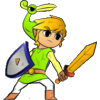This is a small, but important grain of knowledge:
Some users of ZQuest may look at the 'Map Count', and decide to set it at a very large value--much higher than what you are using at present--to prepare for a potentially large game. What you may not realise, is that when you open a quest in Zelda Classic, an amount of RAM is pre-allocated and never released for each map that the game claims to use--even if that map is blank!
The basic guideline, is that ZC uses around 150 MB of RAM, plus 1MB per map. That means that if you assign 256 maps, you can expect ZC to require 470+MB of RAM, on average, potentially more.
The reason for this, is in part due to how FFCs work internally. All 32 FFCs per screen, are loaded when the quest is opened. They are always running, even when not in use. Thus, more maps, equals more screens, and more FFCs to keep in memory.
This also applies to ZQuest, and a smaller map count, will use fewer system resources, in the editor, as well as the ZC player.
If you have ever wondered why some games use hideous amounts of RAM, this is why. The problem, is that memory is not deallocated, so even after quitting the game, the memory footprint isn't resized. If you load a quest, and your RAM usage shoots up, the only way to ensure that you reduce ZC to its minimum footprint, for the next game, is to close the programme entirely, and then re-open it.
If you absolutely need 256 maps, you can use them, but you should only ever allocate as many as you need, at any one time. You can always easily expand the number of maps at any time, should you need more than the amount you set (unless you are using all of them, in which case, you've hit a ZC limitation).
Note that this applies to Maps, not DMaps. Multiple DMaps that share Maps should never increase the memory footprint by any significant factor.
Edited by ZoriaRPG, 03 November 2015 - 04:13 AM.












